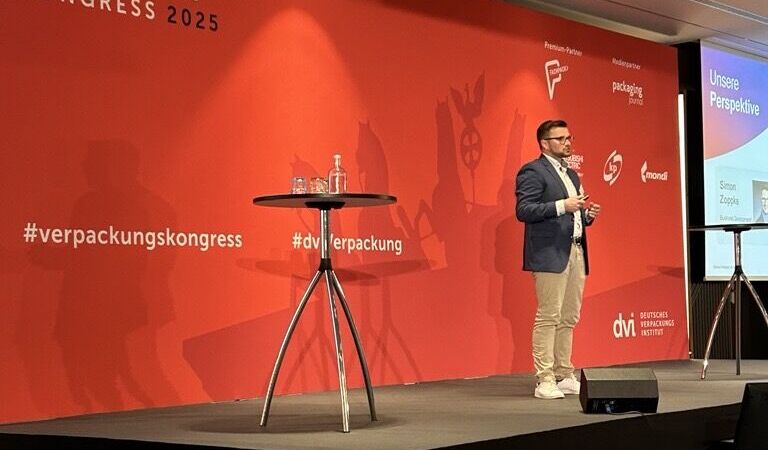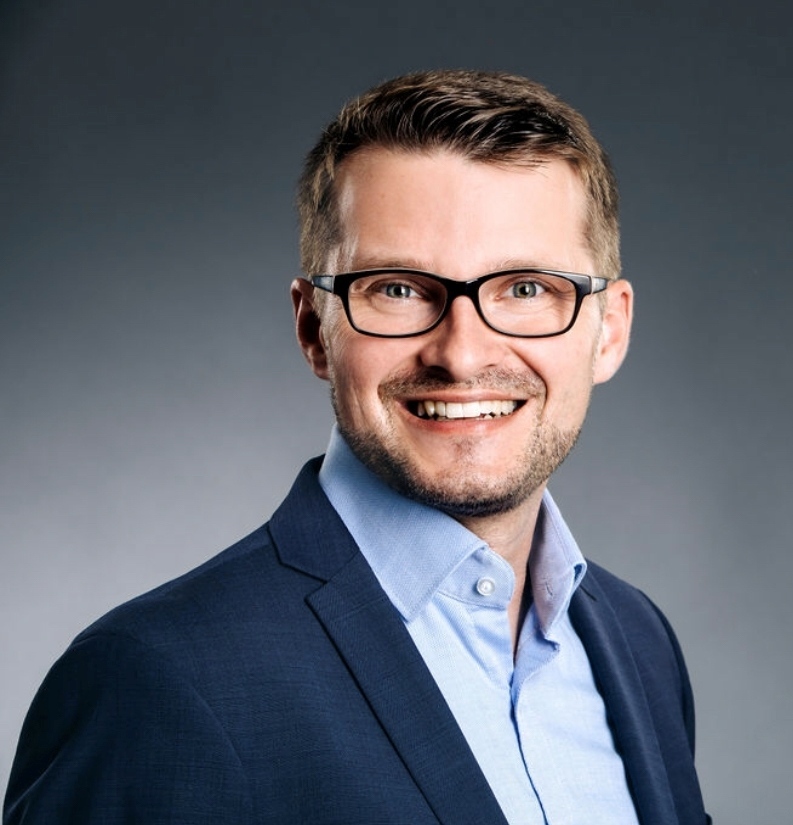The route to a circular future for Europe – Simon Zoppke speaks at German Packaging Congress (DVK) event in Berlin
At the recent Deutscher Verpackungskongress (DVK) 2025 event held in Berlin, our Business Development Manager, Food Packaging, Simon Zoppke, Klöckner Pentaplast opened his presentation with an unusual observation.
He said, “I have never seen plastic packaging running on its own feet into the water.” Out of context, it seems bizarre, but it’s an astute observation that speaks to a necessary shift in how we think about plastics. The context of this statement was that several of the preceding presentations had used imagery of plastics piled on beaches and floating in the ocean – a serious problem, but one that is caused by human behaviour, not by plastic objects.
He said, “I have never seen plastic packaging running on its own feet into the water.” Out of context, it seems bizarre, but it’s an astute observation that speaks to a necessary shift in how we think about plastics. The context of this statement was that several of the preceding presentations had used imagery of plastics piled on beaches and floating in the ocean – a serious problem, but one that is caused by human behaviour, not by plastic objects.
Share this story

Villainising plastic will not get us closer to a circular future – only behavioural change and education can achieve that. And events like DVK are crucial for driving that change, as they are conduits for thought leaders from across the industry to share their ideas and perspectives. At Klöckner Pentaplast (kp), we are proud to be among those thought leaders, so here are the key takeaways from Simon’s well-received presentation.
A new era of legislation
European packaging legislation is undergoing its most significant change in a generation, presenting many challenges and opportunities to businesses.
The EU’s Packaging and Packaging Waste Regulation (PPWR) was published in January. It will phase in a range of new obligations for packaging producers, including restrictions on certain formats; reuse and recycling targets; recycled content targets, and new Design for Recycling (D4R) guidelines enshrined in EU law.
PPWR also contains an extended producer responsibility (EPR) scheme that will be harmonised across all EU member states. This scheme uses modulated fees to incentivise manufacturers to include more recycled and recyclable materials in their packaging.
For more specific details, you can visit our full guide to PPWR.
The EU’s Packaging and Packaging Waste Regulation (PPWR) was published in January. It will phase in a range of new obligations for packaging producers, including restrictions on certain formats; reuse and recycling targets; recycled content targets, and new Design for Recycling (D4R) guidelines enshrined in EU law.
PPWR also contains an extended producer responsibility (EPR) scheme that will be harmonised across all EU member states. This scheme uses modulated fees to incentivise manufacturers to include more recycled and recyclable materials in their packaging.
For more specific details, you can visit our full guide to PPWR.
The road to a circular economy
The key question is what all of this means for packaging manufacturers who already have to deal with continued economic uncertainty across the market. The good news is that the harmonisation of regulations across Europe will likely help create a degree of certainty, supporting greater traceability and efficiency throughout the entire recycling chain.
With the DVK event taking place in Berlin, Simon used Germany as a case study to demonstrate this point. While PET bottles are widely recycled in Germany, supported by initiatives such as deposit return schemes, other PET products such as trays and films have much lower recovery rates as there is a lack of standardised infrastructure and regulations in place to process them.
Changing this should improve the cost-effectiveness of recycled plastics and further incentivise the use of high-quality circular materials like kp 100% Tray2Tray®, which will in turn create more demand for investment in recycling infrastructure.
Crucially, this infrastructure will help simplify recycling for consumers, enabling them to better engage with the circular economy in a way that works for them. To tap into this benevolent cycle, the industry can play its part in increasing plastic recovery rates. While the performance of paper-based materials is continually improving, there are still many sensitive applications for which they are unsuited, meaning it is vital to also ensure there is a robust range of circular, functional plastic solutions making use of verified recycled content.
With the DVK event taking place in Berlin, Simon used Germany as a case study to demonstrate this point. While PET bottles are widely recycled in Germany, supported by initiatives such as deposit return schemes, other PET products such as trays and films have much lower recovery rates as there is a lack of standardised infrastructure and regulations in place to process them.
Changing this should improve the cost-effectiveness of recycled plastics and further incentivise the use of high-quality circular materials like kp 100% Tray2Tray®, which will in turn create more demand for investment in recycling infrastructure.
Crucially, this infrastructure will help simplify recycling for consumers, enabling them to better engage with the circular economy in a way that works for them. To tap into this benevolent cycle, the industry can play its part in increasing plastic recovery rates. While the performance of paper-based materials is continually improving, there are still many sensitive applications for which they are unsuited, meaning it is vital to also ensure there is a robust range of circular, functional plastic solutions making use of verified recycled content.
The kp solution
At kp, we are playing our part in ensuring that this future can become a reality for the packaging industry.
Using kp Elite® trays as an example, we can offer a cost-effective, circular rPET alternative to traditional PP trays. While PP is recyclable, the end markets for recycled PP are limited, as it is not approved for food contact applications. PET and rPET trays, however, are suitable for food contact applications, meaning that they offer true circularity.
This will have an impact under the new PPWR fees. Simon highlighted the estimated costs of purchasing kp Elite® trays in Spain compared to the cost of purchasing the same number of traditional PP trays. Once PPWR fees are taken into account, the kp Elite® trays are significantly less expensive than the PP trays thanks to their use of recyclable rPET material. As these regulations are standardised across the EU, kp Elite® could potentially incur much lower fees in most European markets including Germany.
A clear route to tray circularity is now evident, and innovation from packaging leaders like kp can guide the industry. As we move towards this circular future, kp’s presentations at events like DVK underscore the critical need for industry-wide collaboration and innovation to make the most of these evolving regulatory frameworks. Together, we can achieve circularity in PET tray packaging.
Using kp Elite® trays as an example, we can offer a cost-effective, circular rPET alternative to traditional PP trays. While PP is recyclable, the end markets for recycled PP are limited, as it is not approved for food contact applications. PET and rPET trays, however, are suitable for food contact applications, meaning that they offer true circularity.
This will have an impact under the new PPWR fees. Simon highlighted the estimated costs of purchasing kp Elite® trays in Spain compared to the cost of purchasing the same number of traditional PP trays. Once PPWR fees are taken into account, the kp Elite® trays are significantly less expensive than the PP trays thanks to their use of recyclable rPET material. As these regulations are standardised across the EU, kp Elite® could potentially incur much lower fees in most European markets including Germany.
A clear route to tray circularity is now evident, and innovation from packaging leaders like kp can guide the industry. As we move towards this circular future, kp’s presentations at events like DVK underscore the critical need for industry-wide collaboration and innovation to make the most of these evolving regulatory frameworks. Together, we can achieve circularity in PET tray packaging.

More like this







